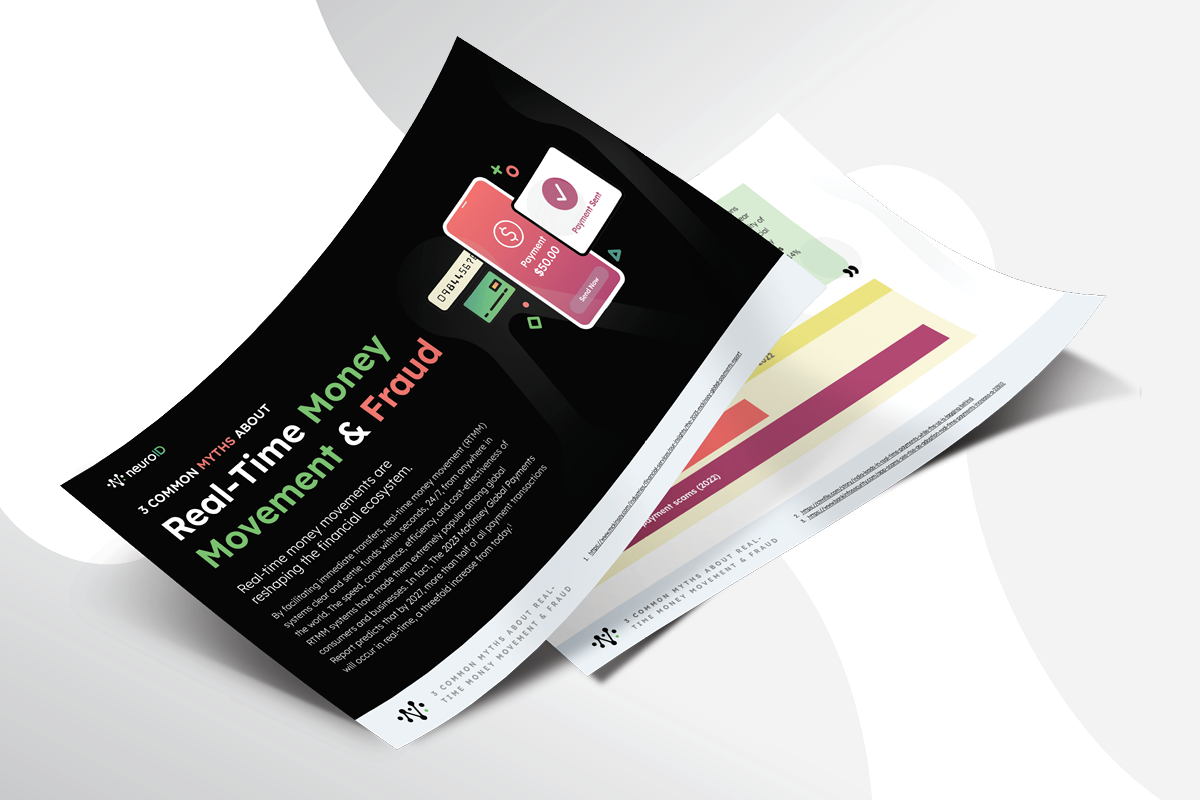
3 Takeaways from Our “Financial Services and Banking Fraud in Real-Time Payments” Webinar
Earlier this month, fraud expert and consultant David Liu (formerly with American Express and Socure) joined NeuroID’s Nash Ali for the first session in our “The Dark Side of Speed: Fraud in Real-Time Payments” webinar series. David and Nash addressed the opportunities, challenges, and solutions facing banks and FIs exploring RTMM, including how liabilities are expected to evolve and where fraud gaps are unexpectedly widening. Here are three key takeaways from their discussion.
Takeaway #1: Fraudsters are flocking to real-time money movement systems
With standard payments, fraud specialists have relied on familiar mitigation strategies. They’ve been able to reduce fraud and create secure, albeit sometimes unsustainable, solutions. But as fraudsters have been locked out of their usual methods, real-time money movements have given them a new, lucrative avenue to exploit (authorized push payment fraud (APP) alone is projected to surpass $3 billion in the US by 2027, largely by targeted RTMM systems).
“As the doors are closing on some kinds of fraud, that squeezes fraudsters to other kinds of fraud,” said David. “With real-time payments, that’s mostly push payments, which means that traditional kinds of transaction fraud mostly aren’t relevant.”
This shift will drastically change how banks and FIs approach fraud mitigation. In standard payment fraud, institutions are afforded time to react to attacks and can often recover losses if fraudsters get through. Real-time transactions, however, are instant and irrevocable, meaning fraud specialists need to proactively prevent fraud and can’t rely on recovering losses after the fact.
“Forever with standard payments, we’ve had the luxury of time. From the time the payment has been initiated, you’ve got enough time to really double click on things and make sure that the payment is genuine,” said Nash. “One thing that always concerns me, having been in the risk management space for as long as I have, is the irrevocability of real-time payments. From a fraud perspective, that’s just a killer because there’s no ability to do a recovery of any kind.”
Takeaway #2: As liability shifts, scam prevention must evolve
In the US, victims currently bear the weight of scams and are held liable for losses—but new laws abroad point towards a change on that front. In the UK, banks and FIs are already responsible for scam losses, and similar legislation has been proposed in the US.
“There’s been a shift in the industry about who ends up holding the bag when fraud impacts us,” said Nash. “I think that the US will follow the UK in placing certain liability for scams on the institutions. If that were to occur, then I question the readiness of institutions in the US. Are they prepared to defend against scams and are they doing enough to mitigate them?”
With banks set to feel the impact of scams more heavily, institutions will need to take a more active role in preventing scams. FIs have pushed scam education, showing consumers red flags to look out for, but haven’t leaped to prioritize scam prevention in their fraud strategies.
“Education is good, but there also has to be some preparedness in terms of tooling,” said Nash. “Forever, we’ve focused our tooling on catching third-party fraud. That tooling needs to change to now capture a true person who is a victim of a scam doing a transaction.”
Takeaway #3: Traditional fraud solutions help, but RTMM systems demand more
Traditional fraud solutions can provide valuable signals, but fraudsters have largely found ways to bypass them. Adding a new, passive signal like behavioral analytics is crucial to building a modern, real-time-ready fraud solution.
“Stopping real-time transaction fraud involves many different signals,” said David. “Adding behavioral analytics allows you to see multiple different sources of information. You start to have even greater confidence and it’s that much harder for the fraudster. Negative device signals are useful, but fraudsters know how to beat them. I don’t think fraudsters are as good at bypassing behavioral analytics.”
Additionally, traditional fraud solutions that rely on manual reviews or batch processing can’t keep up with the speed consumers expect from real-time systems. Customers are seeking instant access, and anything longer will turn them away.
“Consumer expectations shifted because we got used to apps and phones and everything being instant,” David said. “I think the expectation for real-time money movement is that it’s easy to do, it gets there immediately and the person can use it immediately.”
In short: RTMM fraud solutions must provide a smooth, instantaneous user experience without compromising on rigorous fraud prevention measures. By segmenting customers, businesses can avoid forcing genuine consumers through friction-filled, expensive fraud checks while keeping fraudsters out.
“There are a lot of enterprises that create a very rigid way of fraud risk management,” Nash said. “Everybody goes through PII verification exactly the same way, all your consumers go through the same multi-factor authentication process. I’m a firm believer that you have to be able to assess consumer risk early in the funnel and the faster you do that, the less time and effort you spend verifying things you don’t need to.”
The Wide-Reaching Impact of Real-Time Money Movement
As real-time money movements gain traction in the US, banks and financial institutions are feeling pressure to adopt real-time money movement (RTMM) systems. Institutions that wait to embrace real-time transactions could lose business and miss out on billions. RTMM’s momentum is undeniable, but fraud challenges have been a roadblock for many hesitant businesses. —RTMM’s momentum is undeniable. If banks and FIs can’t modernize their fraud solutions, they’ll be subject to potentially massive, unrecoverable losses and regulatory scrutiny.
While the fraud risks of real-time money movements loom over businesses, proper preparation can bring new growth opportunities for FIs and retailers. To learn more about the challenges and opportunities that accompany real-time money movement, join us on February 7 for the second session in our RTMM webinar series, “Fraud & Opportunity Across Borders in Real-Time Payments.”
Some quotes have been lightly edited for clarity and context.



